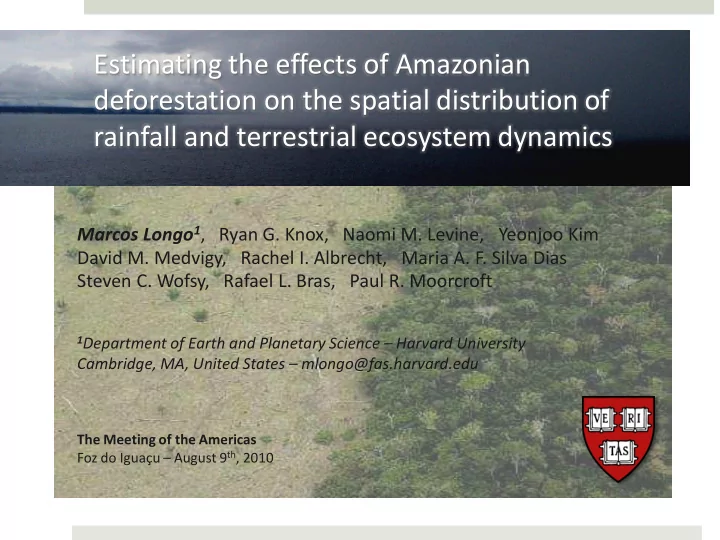

Estimating the effects of Amazonian deforestation on the spatial distribution of rainfall and terrestrial ecosystem dynamics Marcos Longo 1 , Ryan G. Knox, Naomi M. Levine, Yeonjoo Kim David M. Medvigy, Rachel I. Albrecht, Maria A. F. Silva Dias Steven C. Wofsy, Rafael L. Bras, Paul R. Moorcroft 1 Department of Earth and Planetary Science – Harvard University Cambridge, MA, United States – mlongo@fas.harvard.edu The Meeting of the Americas Foz do Iguaçu – August 9 th , 2010
Introductio Deforestation in the Amazon n Goals Results Methods Conclusion s Soares-Filho et al. (2006); Merry et al. (2009)
Introductio Deforestation in the Amazon n Goals Results Methods Conclusion s Soares-Filho et al. (2006); Merry et al. (2009)
Introductio Future scenarios n Goals Results Methods Conclusion s Soares-Filho et al. (2006); Merry et al. (2009)
Woodland breeze? Albrecht (2008) Baidya Roy and Avissar (2002) Smaller scale deforestation: Local circulations due to differential heating; Late dry season: deforested areas are more convective.
Introductio Main goals n Goals Results Methods Conclusion s Understand how the ongoing and the predicted deforestation affect the climate in the Amazon: Precipitation and cloudiness Local circulations Other mechanisms Understand how the ecosystem respond to changes in environmental conditions.
Introductio Coupled model: ED2 levels n Goals Results Methods Conclusion s Moorcroft et al. (2001); Medvigy et al. (2006)
Introduction ED2.1 long term dynamics Goals Results Methods Conclusions
Introductio Coupling between models n Goals Results Methods Conclusion s
Introductio Land use conversion n Goals Results Methods Conclusion s Albani et al. (2006)
Introductio Deforestation scenario runs n Goals Results Methods Conclusion ED-2.1 only, driven with Sheffield et al. (2006) data: s 64-km Potential vegetation: 6 Plant functional types Absolute extinction, steady state, or 500 years Land-use change applied between 1940 and 2039: GLU (Hurtt et al. 2006) between 1940 and 2002 SimAmazonia2 (Merry et al. 2009) between 2010 and 2038 Interpolation between the two periods Coupled runs: ECMWF-Interim reanalysis for Aug-Oct 2008; Land-use state as of 2008 and 2038. 42km over the tropical South America 16km over Amazonas (1-way nesting)
Introductio Deforestation scenario runs n Goals Results Methods Conclusion s
Introductio Above-ground biomass [kgC/m 2 ] n Goals Results Methods Conclusion Total s C4 Grass Early tropical Mid tropical Late tropical
Introductio Deforestation scenario runs n Goals Results Methods Conclusion s
Introductio Precipitation – Sept-Oct 2008 n Goals Results Methods Conclusion s TRMM (3B42) [mm] EDBRAMS - 2008 [mm]
Introductio Changes due to land use n Goals Results Methods Conclusion s
Introductio Change due to land use n Goals Results Methods Conclusion s
Introductio Change due to land use n Goals Results Methods Conclusion s
Introductio Energy terms. 2008 n Goals Results Methods Conclusion s
Introductio Energy terms. 2038 - 2008 n Goals Results Methods Conclusion s
Introductio Differential heating forcing n Goals Results Methods Conclusion s PBL
Introductio Differential heating forcing n Goals Results Methods Conclusion s PBL
Introductio Differential heating forcing n Goals Results Methods Conclusion s PBL
Introductio Forest feedback n Goals Results Methods Conclusion s
Introductio Forest feedback n Goals Results Methods Conclusion s
Introductio Forest feedback n Goals Results Methods Conclusion s
Introductio Concluding remarks n Goals Results Methods Conclusion s Deforestation shifts precipitation distribution: Rainfall reduction at the already deforested coast; (?) Shift in diurnal cycle of precipitation over logged forest Increase in precipitation along the edge of heavily deforested areas Width of deforestation matters!
Introductio Concluding remarks n Goals Results Methods Conclusion s Forest feedback: Little impact on the productivity of the remaining forest far inland; Logged forests experience slight decrease in NEP (temperature and radiation effect); High disturbance environment causes increase in fluxes (?)
Acknowledgements This work has been supported by: CNPq - 200686-2005/4 NASA - NNX08AU95H Especial thanks to: Britaldo Soares Filho The Harvard University Research Computing group, in particular to Christopher Walker Matthew Hayek V. Y. Chow Bruno Biazeto Alexander Antonarakis Carla Barger
Introductio Forest or cerrado? n Goals Results Methods Conclusion s Oyama and Nobre (2003) Cox et al. (2004) Frequent droughts (and fires) favors cerrado Range in which both biomes are possible Changes in climate ➜ savannization?
Not a homonegeneous place Saatchi et al. (2008) Myneni et al. (2007) Biodiversity has significant spatial patterns; Seasonal “greenness” despite being evergreen.
Is the forest the only stable state? Cox et al. (2001) Oyama and Nobre (2003) Cerrado could be also stable on the eastern half; CO 2 : Increased water use efficiency; Longer droughts cerrado is favored;
Introductio Future scenarios n Goals Results Methods Conclusion s Soares-Filho et al. (2006); Merry et al. (2009)
Introductio Paved road effect n Goals Results Methods Conclusion s BR-364 Source: Landsat 5, available at PRODES/INPE
Introductio Paved road effect n Goals Results Methods Conclusion s BR-364 Source: Landsat 5, available at PRODES/INPE
Introductio Coupled model: BRAMS-4.0.6 n Goals Results Methods Conclusion s Advection Tremback et al. (1987) Convection Grell and Dévényi (2002) Turbulence Radiation Nakanishi and Niino (2004) Harrington et al. (2000) Toon et al. (1988)
Land heterogeneities force circulations Land/water heterogeneity generates clouds: Large-scale sea-breeze developing squall lines; River-breeze creating minimum convection over rivers.
Impact of deforestation on climate d ’Almeida et al. (2007) Local deforestation: local circulation effect dominates; Large-scale deforestation: evapotranspiration effect dominates;
Introductio Diurnal energy cycle n Goals Results Methods Conclusion s
Introductio Differential heating n Goals Results Methods Conclusion s
Recommend
More recommend